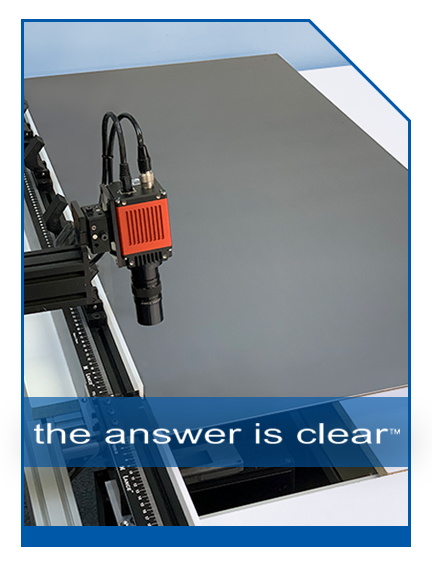Laser Cut Edge of Si Wafer
The image above was acquired with the GFP™1500. The GFP™2600 Stress Measurement System is fully capable of acquiring the same stress image; however, with the GFP2600, image acquisition is instantaneous!
Product Overview » Dedicated Systems » GFP2600 NIR/SWIR
Product Overview » Dedicated Systems » GFP2600 NIR/SWIR
The GFP™2600 NIR/SWIR Real-time Photoelastic Stress Analysis (PSA) System instantaneously measures stress through NIR/SWIR transparent materials such as silicon wafers, silicon coated glass, and many ceramics. Systems include a NIR/SWIR circularly polarized illuminator and an analyzing camera. Cameras can be configured to provide an area field of view (FOV) or a strip FOV. The strip data can be stitched together to create extremely large images.
The cameras are fixed focal length, but can focus close to find small defects such as particles trapped between bonded wafers, or they can focus far to inspect whole wafers. Similarly, for silicon coated glass, you can focus close on edge stress or far to inspect the full width. The specific camera, NIR (750–1000nm) or SWIR (1000–1700nm), is selected in combination with a bandpass filter to optimize performance for a given material or application.


Among many other features, the software provides:
The GFP2600, in conjunction with the NIR/SWIR Illuminator, allows for full-field stress images of transparent materials such as silicon wafers, silicon coated glass, and many ceramics. Easily collect accurate and quantifiable stress data over whole wafers or focus close to find small defects such as particles trapped between bonded wafers to solve problems in manufacturing or to create a database of stress information.
| SPECIFICATION | VALUE |
|---|---|
| Range | 1/2 λ Filter |
| Repeatability | 2% |
| Accuracy | 0–10 nm ± 0.5nm 10–100 nm ± 5nm 100 nm–range ± 5% |
| Frame Rate | 10 f/s |
| Resolution | Camera Dependent |
| Focal Length | Fixed 20 nm, 30 nm |
| Interface | GigE |
| Specifications are general. Definitive specifications are determined by application and will be reflected in final quote. |
The GFP2600 NIR/SWIR Real-time Photoelastic Stress Analysis System acquires instantaneous stress images or videos via kaleidoscopic optics. The system creates multiple copies of the stress images—all exposed to different sets of polarizing optics. Powerful algorithms process the images to produce real-time photoelastic stress images. The results are based on two fundamental images referred to as:
Need help? Email our expert support team via our contact form or call us at +1 (608) 224-1230
Need help? Email our support
team via our contact form
or call us at +1 (608) 224-1230

Glass Photonics was founded by Stress Photonics to better serve the glass industry.
All products are manufactured by Stress Photonics Inc.